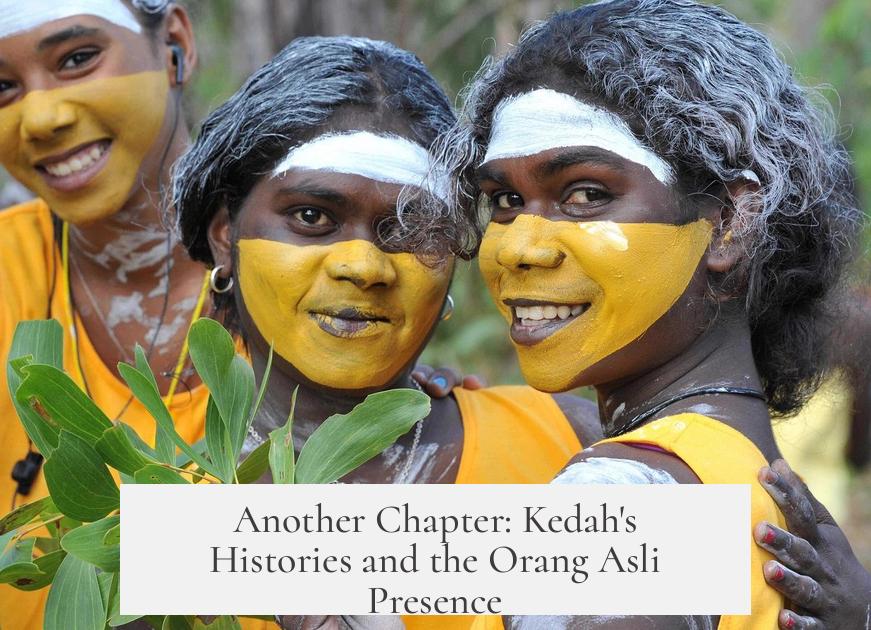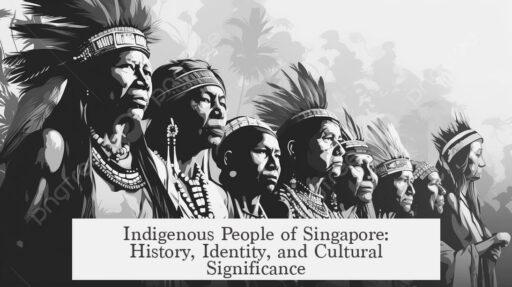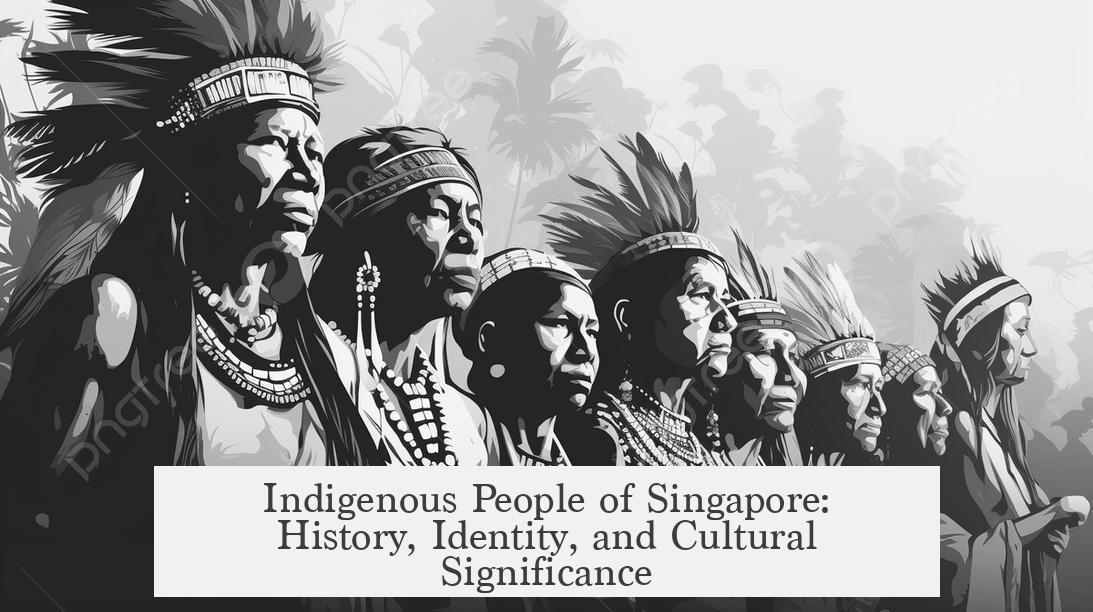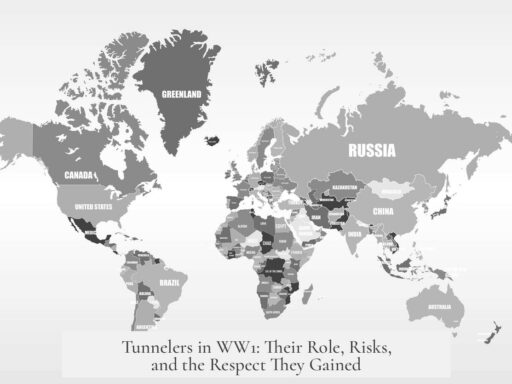The indigenous people of Singapore are constitutionally recognized as the Malays, who hold a special status under Article 152.2 of Singapore’s Constitution. This legal recognition reflects their position as the earliest identifiable community on the island prior to British colonial settlement. The Malays are thus officially regarded as the indigenous population, with the government tasked to protect and promote their political, educational, religious, economic, social, and cultural interests.
The term “indigenous” in Singapore refers to peoples who inhabited the region before the influx of British colonial and immigrant populations, particularly the large waves of Chinese, Indian, and European settlers. This definition aligns with how the Malay community is understood within Singapore’s historical and socio-political context.
Globally, there is no single accepted definition of “indigenous people.” The United Nations defines indigenous groups as descendants of those who lived in a country at the time when other groups arrived and eventually became dominant through conquest, settlement, or occupation. In this sense, Malays meet the UN criteria since they lived in the area before and during British colonization, while later immigrant groups became dominant after their arrival.
The concept of indigeneity is fluid and contextual. For example, earlier populations, such as the Orang Laut and Orang Asli, would also have been indigenous before Malays established their prominence. Over time, Malays became the primary indigenous group recognized in Singapore, especially due to their continuous cultural and political presence.
Anthropologically, Singapore’s very first human inhabitants might have been “negrito” peoples arriving some 70,000 years ago. These groups, characterized by dark skin, short stature, and frizzy hair, once occupied parts of Southeast Asia, including what is now Singapore. Later, “mongoloid” groups migrated from southern China and Taiwan, gradually displacing or integrating with negrito populations. Surviving remnants of negrito peoples today reside in neighboring regions such as Malaysia and the Philippines.
Despite the deep history of earlier inhabitants, Malays themselves acknowledge they did not originate as the earliest inhabitants of the region. Historical Malay texts, like the Sejarah Melayu (Malay Annals), describe Malays as migrants settling in Singapore and the Malay Peninsula. The Sejarah Melayu traces Malay royal lineage to legendary foreign figures such as Alexander the Great, emphasizing an origin narrative involving migration and adoption rather than autochthony.
The Sejarah Melayu portrays the establishment of Malay polity on the island, supported notably by the indigenous Orang Laut (sea people), who lived around Singapore and nearby islands. Malays founded settlements such as Singapura under these alliances, and subsequent regional sultanates modeled themselves on Malacca’s legacy, influencing Malay identity and language.
Another significant historical source, the Hikayat Merong Mahawangsa, recounts the Hindu-Buddhist rulers of Kedah, a northern neighbor, also tracing their origins to external figures and referencing the presence of Orang Asli populations prior to Malay arrival. This further confirms the layered settlement history of the region, where different groups successively inhabited the land.
In Singapore today, the recognition of Malays as indigenous is thus a combination of historical precedent, cultural continuity, and legal affirmation. While anthropology points to much older inhabitants, and historical records emphasize migration and interaction, the constitutional and social consensus centers on Malays as the island’s indigenous community. This recognition supports safeguarding their language and heritage amid Singapore’s diverse, multicultural landscape.
- Singapore’s Constitution formally recognizes Malays as the indigenous people of Singapore.
- “Indigenous” refers to communities present before British colonial rule.
- The UN defines indigenous people as original inhabitants before conquest or settlement by others, which fits the Malay community.
- Earliest humans in Singapore were negrito peoples arriving tens of thousands of years ago.
- Historical Malay texts describe Malays as migrants supported by native Orang Laut.
- Malay identity today is shaped by history, migration, and legal recognition.
Who Are the Indigenous People of Singapore? Peeling Back the Layers of Time and Identity

At its core, the indigenous people of Singapore are the Malays, recognized constitutionally and historically as the original inhabitants before British colonial influx transformed the island’s demographic landscape. But this answer, simple as it sounds, opens a rich, complex story of migration, identity, and interpretation that’s worth exploring.
When Singapore’s Constitution mentions “indigenous people,” it refers specifically to the Malays. According to Article 152.2, the Singapore government must protect and promote the special position of Malays—it’s right there in black and white. This recognition includes safeguarding their political, educational, religious, economic, social, and cultural interests, along with promoting the Malay language. That’s a firm legal anchor you can’t miss.
But what exactly does “indigenous” mean here? It’s tempting to imagine indigenous as the very first humans who ever set foot on Singapore’s soil. However, the Singaporean context draws a different line in the sand. Here, indigenous refers to the people present before the flood of British colonial-driven immigrants—mainly the massive influx of Chinese, Indians, and Europeans. By this logic, the Malays aren’t the island’s first-ever inhabitants, but they are the original community before modern Singapore’s multi-racial makeup took shape.
The United Nations Perspective: Defining Indigenous People
The United Nations doesn’t have an official, one-size-fits-all definition of “indigenous people,” which complicates things globally and locally. However, they offer a practical definition: indigenous people are descendants of the original inhabitants at the time other cultures or ethnic groups arrived and later dominated through conquest or settlement.
This fits the Malay population of Singapore perfectly. Malays were already living on or around the island when British colonial powers arrived and changed the demographic order. Interestingly, this definition also means a group can be both immigrant and indigenous at different moments in time. For example, other earlier communities like the Orang Laut and Orang Asli qualify as indigenous per this definition during different historical periods, before the Malays became dominant.
Who Were the Earliest People on Singapore’s Soil?
Before the Malays, who actually lived here? Let’s get a bit anthropological. The earliest humans in Southeast Asia—and Singapore—are believed to be the Negritos, arriving some 70,000 years ago. These people had distinct physical traits: dark skin, frizzy or spiraled hair, and short stature.
Then came the Mongoloid group, migrating from Taiwan and southern China, gradually mixing with or displacing the Negritos. Though few pure Negrito communities remain today (like the Aetas in the Philippines or Orang Semang in Malaysia), they are likely the island’s very first human inhabitants. Yet, they don’t carry the “indigenous” label in today’s Singapore context.
The Malays: Settlers or Natives? A Historical Ballet
The Malays themselves acknowledge they’re not the first ever to inhabit Singapore and its neighboring Malay Peninsula. The Sejarah Melayu (Malay Annals), a romanticized yet essential historical text from the early 17th century, sheds light on this.
The Sejarah Melayu tells fascinating stories—the Malay rulers trace their lineage not to local tribes but to legendary figures like Alexander the Great. For those who raise eyebrows, yes, a dash of Alexander’s bloodlines in Singaporean history! Sri Tri Buana, one supposed descendant, founds Singapura after arriving by sea, aided by the Orang Laut, the original people of the waters around the islands.
This narrative makes a clear distinction between the Malays as settler rulers and the Orang Laut as native seafarers. It suggests a layered identity where the Malays, while not the earliest dwellers, established the local culture and political system influencing the region for centuries.
Another Chapter: Kedah’s Histories and the Orang Asli Presence

The Hikayat Merong Mahawangsa, another set of annals from the nearby Sultanate of Kedah, also paints a picture of migration, lineage, and indigenous life. Like the Malacca story, Kedah’s earliest rulers are traced to Alexander’s legacy, and the script references the Orang Asli—earlier inhabitants already settled in the area.
Thus, the Orang Asli, often overlooked, represent the true original people before even the Malays arrived. Their continued existence today reminds us of the complex ethnic layers beneath Singapore’s modern identity.
What Does This Mean Practically?
Understanding who the indigenous people of Singapore are impacts socio-political policies, cultural preservation, and community identity.
To start, the governmental responsibility to safeguard Malays implies recognition of their unique role and heritage. It influences education, language use, and public support mechanisms targeting Malay interests. But beyond institutional acknowledgment, it creates a sense of identity and history.
This acknowledgment also raises interesting questions: How do we reconcile the idea that Malays are indigenous but were themselves once migrants? What about the Orang Laut and Orang Asli, who predate Malays on the island? These nuances dispel simplified notions of indigeneity and highlight migration’s role in shaping identities across centuries.
Why Does This Matter Today?
Singapore is often praised for its multiculturalism and harmony. But multiculturalism isn’t just about mixing cultures; it’s about respecting origins and histories. When Singaporeans recognize the Malays as the indigenous people, it does more than fulfill a constitutional rule. It honors a long, complex journey of people who shaped the island before it became the global city it is today.
It’s also a reminder that identity isn’t static. People migrate, cultures blend, and history often surprises us. For example, the Malays’ connection to Alexander the Great sounds like an epic tale rather than simple history. Yet, it frames the Malay identity as a combination of influences, both local and far-flung.
What Can We Learn From This?
- Historical Identity Is Complex: Indigenous isn’t always about first arrival. It encapsulates who played foundational roles before the modern era’s upheavals.
- Recognize Multiple Layers: The Orang Laut and Orang Asli remind us of the deep roots beneath current dominant cultures.
- Celebrate Cultural Legacy: Malay culture, language, and traditions have shaped Singapore profoundly; preserving them honors the island’s original cultural fabric.
Singapore today is a tapestry of many threads woven over millennia. Understanding the indigenous Malays’ story adds depth. It’s like knowing the backstory of a bestseller novel, enriching your reading experience.
So the next time you ponder who truly owns the roots of Singapore, remember it’s not just the current demographic snapshot. It’s the Malays, recognized as indigenous, standing on a foundation laid by even older communities like the Orang Laut and Orang Asli. And like any rich history, it’s full of surprising twists, migrations, and connections as grand as tracing lineage to Alexander the Great!
For Further Exploration
- Read the Sejarah Melayu to dive into Malay historical legends.
- Explore anthropological studies on Negritos to understand Southeast Asia’s earliest peoples.
- Research Singapore’s Constitution Article 152.2 for a legal perspective on indigenous policies.
Are you ready to see Singapore not just as a city-state but as a living story book of migrations, cultures, and identities? The Malays as indigenous people are just one chapter—and a fascinating one at that.




